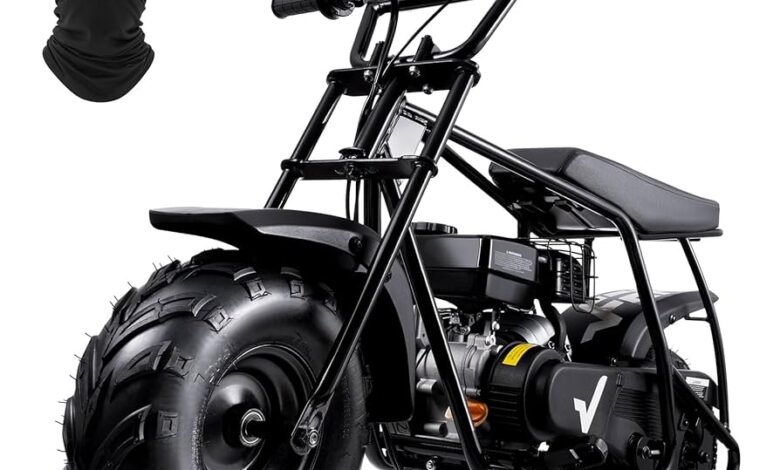Mini Bikes: Small Wheels, Big Fun — The Ultimate Guide for Beginners and Enthusiasts

There’s something undeniably cool about a mini bike. Maybe it’s the compact frame, the growl of the small engine, or the fact that riding one instantly makes you feel like a kid again. Whether you’re brand new to mini bikes or a seasoned rider, these pint-sized powerhouses pack a surprising amount of fun and functionality into a small frame.
But mini bikes are more than just toys—they’re real machines with real capabilities. From backyard riding to off-road adventures, these bikes have carved out a niche that’s only growing in popularity. In this article, we’ll explore what mini bikes are, why people love them, how to choose the right one, and how to stay safe while riding. Ready to roll? Let’s go.
What Is a Mini Bike, Anyway?
If you’ve ever seen a tiny motorcycle zipping around a backyard or track, chances are you’ve spotted a mini bike. These bikes are exactly what they sound like: small-sized motorcycles, typically designed for fun, casual riding, and sometimes even competitive racing.
A Brief History of Mini Bikes
Mini bikes first gained popularity in the 1960s and 70s as DIY backyard projects. People built them from spare parts, welded frames in garages, and popped on small lawnmower engines for power. What started as a fun experiment quickly evolved into a full-blown hobby. Today’s mini bikes have evolved significantly in design and performance, but they still hold that original charm of DIY fun and simple mechanics.
You’ll now find everything from electric mini bikes for kids to high-performance gas-powered mini bikes capable of impressive speeds and handling. And because they come in so many forms, mini bikes appeal to a wide range of riders—kids, teens, adults, hobbyists, and even racers.
Defining Characteristics
A typical mini bike has a low frame, small wheels (often 6-10 inches), and either a gas or electric motor. Unlike dirt bikes or scooters, mini bikes usually have a simple design, minimal suspension, and a throttle/brake system that’s very beginner-friendly.
While they might not be street-legal in most areas, they’re perfect for private properties, dirt trails, go-kart tracks, and even indoor circuits in some cases. Because of their size and speed, they’re generally considered safer and easier to learn on than full-sized motorcycles.
Not to Be Confused with Pocket Bikes
It’s easy to mix up mini bikes and pocket bikes, but they’re not quite the same thing. Pocket bikes are smaller, lower, and typically designed for racing on smooth surfaces. Mini bikes, on the other hand, are a bit larger and more versatile—they’re better suited for rough terrain and casual riding. So if you’re planning to take your ride off-road or around the neighborhood, a mini bike is the better choice.
Why Mini Bikes Are So Popular Right Now
Mini bikes aren’t just nostalgic—they’re making a major comeback. With the rise of DIY culture, affordable motorsports, and social media influence, mini bikes are once again in the spotlight.
Affordable Entry Point into Motorsports
One of the biggest draws of mini bikes is that they’re relatively affordable. You don’t have to drop thousands of dollars on a dirt bike or street motorcycle to get the thrill of two wheels. Most quality mini bikes fall in the $300–$1,200 range, depending on size, brand, and engine type. That makes them accessible to a lot more people—especially those just testing the waters.
They’re also cheaper to maintain. Because the engines are simple and the frames are smaller, replacement parts and repairs are much more budget-friendly than those of larger bikes.
Great for Learning and Building Confidence
If you’re teaching a young rider—or even learning yourself—a mini bike is the perfect starting point. The smaller frame makes them easier to balance, and lower speeds reduce the risk of injury. Plus, the simplicity of the design means riders can focus on mastering basic skills like throttle control, braking, and steering without getting overwhelmed.
For mechanically inclined folks, mini bikes also offer a fun opportunity to tinker and learn about engines. Many riders get into mechanics by customizing or repairing mini bikes in their garage.
Social and Community Fun
Mini bikes are more fun when shared. Whether you’re riding around with friends, competing in mini bike races, or joining a local meet-up, there’s a strong community around these tiny machines. From YouTube channels to Reddit forums, there’s no shortage of tips, tricks, and wild videos of people pushing the limits of what a mini bike can do.
Plus, many people enjoy customizing their mini bikes—adding lights, decals, new seats, bigger tires, or even turbocharging the engine. It’s a hobby that keeps on giving.
Choosing the Right Mini Bike for You
Buying a mini bike can feel a bit overwhelming if you’re new to it. With so many models and types available, how do you know which one is right for you? Let’s break it down.
Gas vs. Electric
Mini bikes come in two main flavors: gas-powered and electric. Gas mini bikes offer more power and longer run times, making them ideal for off-road riding and adults who want some serious fun. They typically have engines ranging from 40cc to 200cc.
Electric mini bikes, on the other hand, are quieter, cleaner, and often easier to maintain. They’re great for kids or indoor riding, and some models can still pack a punch in terms of torque and speed. The trade-off is usually battery life—most electric bikes last around 30–60 minutes per charge.
Size and Rider Weight
Make sure to check the weight limit and seat height. Mini bikes might look tiny, but many of them are built for adult riders too. If you’re buying for a child, go for a smaller frame with lower seat height and slower top speed. For teens and adults, look for models that can handle higher rider weight and have a bit more engine power.
Brands like Coleman, MotoTec, and Razor make some of the most popular mini bikes on the market and offer models for both kids and adults.
Intended Use
Think about where you’ll be riding. If you’ve got a backyard or trail, a gas mini bike with rugged tires is a solid pick. If you want to zip around a parking lot or driveway, an electric bike might be more convenient and neighborhood-friendly.
Also, check local laws—some areas have strict regulations on motorized bikes, especially for kids or public road use.
Mini Bike Safety: Don’t Skip This Part
Sure, mini bikes are fun—but they’re still motorized vehicles. That means safety should always come first, no matter how small or slow the bike may seem.
Always Wear Protective Gear
At minimum, you should always wear a DOT-approved helmet. For younger riders or more intense off-road use, it’s a good idea to add gloves, knee/elbow pads, boots, and long sleeves. Even a minor fall can cause scrapes, so better to be safe than sorry.
Some parents mistakenly assume that because mini bikes are small, they don’t require helmets—but even at 15–20 mph, a crash can cause serious injury. Gear up every time.
Ride in Safe, Supervised Areas
Avoid busy streets or public roads unless you’re certain it’s legal and safe. Stick to driveways, trails, and private land where there’s minimal traffic. Supervision is key for younger riders, and it’s smart to set clear boundaries on where and when they can ride.
Also, check your bike before each ride. Make sure the brakes are working, tires are inflated, and there’s no damage to the throttle or frame.
Learn the Controls First
Before opening up the throttle, take time to learn how the bike responds. Practice turning, stopping, and starting smoothly. Most accidents happen when riders get too confident too quickly. Spend time learning the basics, and you’ll have a much better (and safer) experience.
Final Thoughts: Big Thrills Come in Small Packages
There’s a reason the mini bike has stuck around for decades—it’s small, accessible, and a ton of fun. Whether you’re looking to relive your childhood, teach your kid to ride, or simply enjoy a new outdoor hobby, mini bikes offer a unique blend of freedom, learning, and adrenaline.
From gas-powered beasts to whisper-quiet electrics, the mini bike market is bigger than ever. And with the right safety gear, a little maintenance, and some open space, you’re in for an experience that’s more than worth the ride.
So go ahead—start small, ride big.



